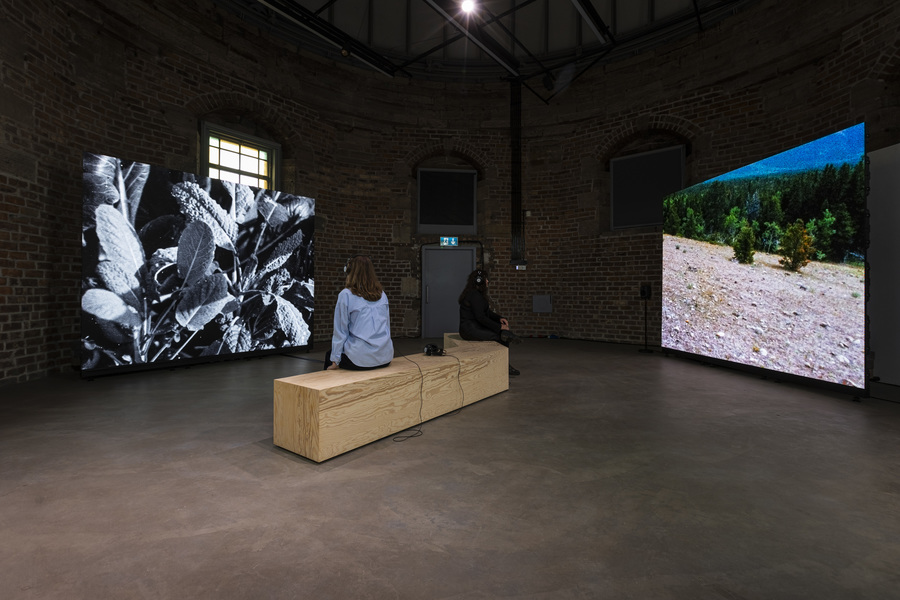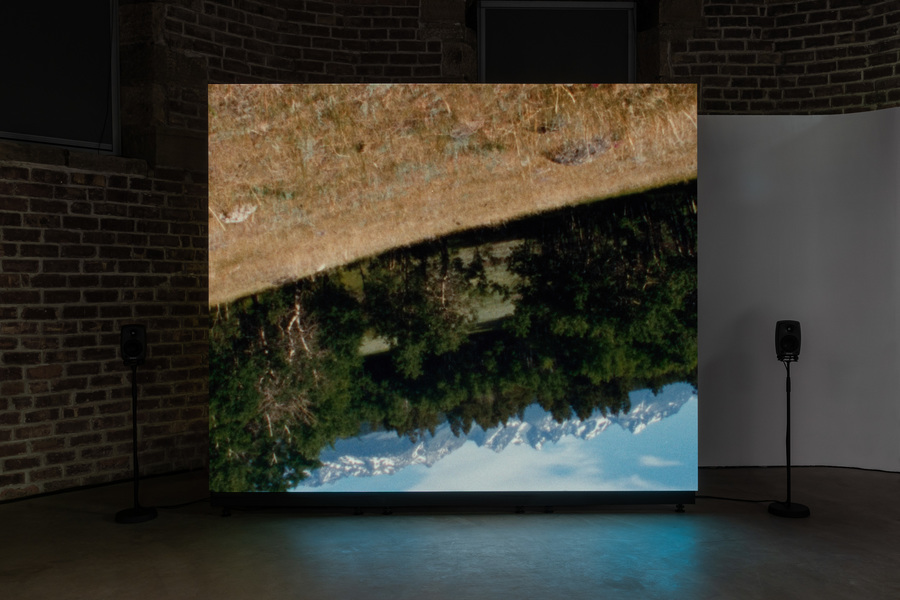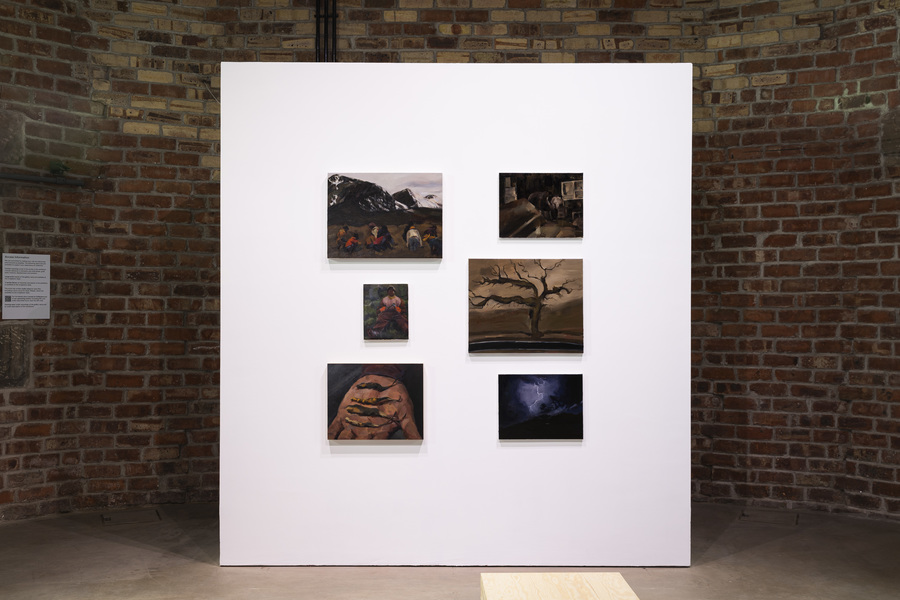Rethinking Roots: Shen Xin on Highland Embassy
We speak with Isle of Skye-based artist Shen Xin about the ecological and spiritual themes running through their exhibition at Collective in Edinburgh
Presented at both Collective in Edinburgh and TINA in London, Bearing fruit of fondness (2025) uses the leaves of the cotoneaster plant, a so-called ‘invasive species’ that affects local habitats on the Isle of Skye, where you live and work. How do you use this particular plant to ground the film's narrative and themes?
A plant inherently is a manifestation of stories, elemental stories of how it came to be, and elemental relations of how it arrived or departed from history and place. I spent a long time just listening and sensing these stories of cotoneasters, free of hierarchies of ways in knowing, for its abundance is part of the everyday path at home, the change of seasons, and effecting the giving and taking of life for many beings that the plant touches.
I do not intend to have a relationship with cotoneaster based on any particular one of its stories: how it was brought to the UK in the 19th century as an ornamental plant from Eastern Asia; its medicinal values in relating to the flow of air and blood across various traditions and practices; or how certain types of cotoneasters are considered ‘invasive’ due to the limestone landscape in Scotland.
I see a plant that is a manifestation of relationships coming together in different places and times, as if it’s involved in a magical display through time and space. It is from this perspective of insight [that] I worked with its abundance by managing its growth at home, and used the leaves of cut plants to make developers for the images of life lived while uniting with a sense of belonging that is unhurt. It’s unhurt because, just like the plant, the capacity to belong in every one of us is abundant. I think it’s important to be able to really see my collaborators – in this case, the cotoneaster – when we engage in working together.
I am interested in the pace of narration, which takes the form of spoken poetry, in your film work. You’ve also written and illustrated a short children's story, The child of the mountain (རི་ཕྲུག in Tibetan), which reflects on the overharvesting of caterpillar fungus in Tibet. You’ve described language as “a way of honouring relationships”, and have been learning Tibetan, Scottish Gaelic, and Arabic languages through your life and artistic practice. What is the relationship between the visual and verbal forms in your work?
In the embodied practice through Buddhism, language [...] bears awareness of the coming together of forms and signs, [and] the phenomena of how the object of perception momentarily attaches itself to names, appearances and identities. Language walks this path of awareness, that it can become a form of violence that has the capacity to harm. Language is a way to honour relationships, just like moving image is awareness in action.
It comes back to how one can truly see your collaborator as I mentioned earlier. Any visual or verbal forms require insight, in order to hold each other in this spaciousness of being able to relate and erode freely.
I see the practice of filmmaking as a path to realise the extremity of non-violence. bell hooks was a Buddhist practitioner, and I recall her advocating for the creation of a structure – a love ethic, be it personal or social – that does not have the capacity to oppress another. Every kind of knowledge, when falling into the extremes in various combinations of objecthood and nihilism, will inherently have the capacity to oppress. The same goes for identity, culture, pain, complexity, complicity, language, image, sound, meaning, discovery, etc. If we fail to see the transient nature, or kindred capacity, of the objects of grasping that we engage with every moment, we risk creating oppressive potentials in what we make.
When it comes to the languages I’m learning and living/making with, I think there are a few things worth mentioning. Tibetan grammar, as my teacher Franziska Oertle has introduced to us, is based on the selflessness of the self, and the selflessness of the phenomena.
This is reflected in how one speaks about what one knows: the relationship to the object of knowing is an important part of expressing knowingness. Whether you were there when it snowed, or perhaps you heard it from someone else, can be sensed by the listener when you tell them ‘It snowed’. Knowledge is never not a verb, which has similar resonance in Scottish Gaelic, where you would express your name, some emotions, and sensations like hunger as if you are wearing them on your body. My moving image practice is of the awareness of manifestation, and through it I hope to create space for the awareness of the perceiver.
Temples are inspirations for some of your other film works, including The Gay Critic (2015) and Strongholds (2016), which focuses on the Tibetan Buddhist temple in Scotland, the first and once largest in Europe. How have you related your interests in ritual and spirituality to the particular context of the Observatory on Calton Hill?
The kind of spirituality that I’m tuned into is one that allows a continuous erosion of understanding, that is uncompromising in its practice, and one that is embodied, namely Buddhism. The exhibition’s title, Highland Embassy, alludes to this process. I believe that it can be the practical and relative position of an embassy, one that is open to change through collaborations; in this case, the visitors and the place are its collaborators.
The observatory on Calton Hill requires a natural climatisation to its location, altitude, view and history, that comes from journeying towards the gallery. The round spatial structure inside the space is treated in this exhibition as separate stories that welcome the encounter. Embassy is also an idea that engages cotoneaster and other so-called invasive species, so that they might transform from being unintegrated to having relational capacity.
Your practice considers the intersections of ecological and ethnic identities; importantly, you refer to the land, not the nation state, of China. Often, environmental interest and activism begins from a position of altruism. How, from our own personal positions, can we explore wider environmental and ecological themes?
Thank you for the insight. I think that perspective, along with the question of personal positions, is precisely a view I’m trying to cultivate. As a lot of my teachers have said in different ways, true giving is without the giver, the gift, or the receiver. True giving is an action coming from being able to see the deepest ecological connections between all things, the acceptance that oneself and another are never separate beings.
In this way, we might be uncompromising in our exploration of relating to environmental and ecological realities, as we develop our capacity to fearlessly relate to all forms of manifestation, with the confidence that is cultivated by the insight of our togetherness on a fundamental level. This confidence is also the greatest source of resistance against any sort of politicisation of identity when it comes to demarcations drawn by the need of nation-states. In order to practice it, the disintegration of dualism as a pattern has no space for compromise, it doesn’t negate nor objectify what has manifested. In the case of moving image works, it often employs a witnessing through the conscious engagement of appearances as deceptions, and magic.
Many of your works explore indigenous identities and practices – or, as curator Alvin Li suggests, “ethnic others” – in different contexts. Unfortunately, a singular term of ‘Indigenous art’ remains present within our contemporary art, historical, and media landscapes. Could you describe the importance of comparative study, and plurality, in your work?
In being fixated to terms and discourses, as an effect, our collective agency might be held in suspense. The coming together of multitudes is often about acknowledging the capacity to host stories of others by others. It’s significant because I believe that it’s our inherent capacity to love the kindred. But this love requires skillfulness, diligence, compassion, patience, moderation, and many other forms of power. I feel that one’s artistic practice can be a good way to realise that too.
Shen Xin: Highland Embassy, Collective, Edinburgh, until 21 Dec
collective-edinburgh.art/programme/highland-embassy


